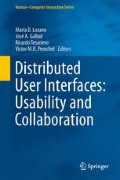Abstract
Collaboration is essential in healthcare environments for a wide variety of tasks and situations. Health practitioners have to perform complex tasks, which in turn are divided in more simple ones and workers can assist each other when doubts or unexpected situations occur. In the latter case, if the situation is an emergency, it needs to be solved first and then, pending tasks are again reorganized within their well-defined agenda. These changing conditions, which might result in an adaptation of the employees’ behavior, create the need of ubiquitous and context-aware software that offers information and functionality based on their needs. Additionally, many healthcare employees need to use the same application through different devices depending on their context, as they are constantly moving around the environment. The system should adapt its display window based on the device restrictions through a distributed user interface. In this paper, we present Ubi4health as a system whose main features include the aforementioned healthcare requirements. The system presents, as a differential factor in healthcare settings, the use of the distributed user interface paradigm within ubiquitous environments, which favours the collaborative work. Finally, we present the outcomes of the usability evaluation performed on the system based on the ISO 9126–4.
Access this chapter
Tax calculation will be finalised at checkout
Purchases are for personal use only
References
Arnrich, B., Mayora, O., Bardram, J., & Tröster, G. (2010). Pervasive healthcare, paving the way for a pervasive, user-centered and preventive healthcare model. Methods of Information in Medicine, 1, 67–73.
Bardram, J. E. (2004). Application of context-aware computing on hospital work – Examples and design principles. 2004 ACM Symposium on Applied Computing.
Madeira, R. N., Postolache, O., Correia, N., & Silva, P. (2010). Designing a pervasive healthcare assistive environment for the elderly. Ubicomp.
Sneha, S., & Varshney, U. (2009). Enabling ubiquitous patient monitoring: Model, decision protocols, opportunities and challenges. Decision Support Systems, 26, 606–619.
Bick, M., & Kummer, T. (2008). Ambient intelligence and ubiquitous computing. Handbook on Information Technologies for Education and Training. Springer Berlin Heidelberg.
Cousins, K. C., & Varshney, U. (2009). Designing ubiquitous computing environments to support work life balance. Communications of the ACM, 52, 117–123.
Want, R. (2010). An introduction to ubiquitous computing. International chapter book ubiquitous computing fundamentals. Boca Raton: Chapman and Hall/CRC.
Weiser, M. (1991). The computer for the twenty-first century. Scientific American 265.
Horn, D. B., Finholt, T. A., Birnholtz, J. P., Motwani, D., & Jayaraman, S. (2004). Six degrees of Jonathan Grudin: A social network analysis of the evolution and impact of CSCW research. ACM Conference on Computer Supported Cooperative Work (pp. 582–591).
Johansen, R. (1998). Gropware: Computer support for business teams. New York: The Free Press.
Johnson-Lenz, P., & Johnson-Lenz, T. (1981). Consider the groupware: Design and group process impacts on communication in the electronic medium. In S. Hiltz & E. Kerr (Eds.), Studies of computer-mediated communications systems: a synthesis of the findings. Newark: Computerized Conferencing and Communications Center, New Jersey Institute of Technology.
Poltrock, S., & Grudin, J. (1999). CSCW, groupware and workflow: Experiences, state of arte, and future trends. In CHI’99 extended abstracts on human factors in computing systems (pp. 120–121). New York: ACM Press.
Poltrock, S., & Grudin, J. (2005). Computer supported cooperative work and groupware (CSCW). Interact.
Anagnostopoulos, T., Tsounis, A., & Hadjiefthymiades, S. (2006). Context awareness in mobile computing environments. Wireless Personal Communications, 42, 445–464.
Bricon-Souf, N., & Newman, C. R. (2007). Context awareness in health care: A review. International Journal of Medical Informatics, 76, 2–12.
Dey, A. K., & Abowd, G. (2000). Towards a better understanding of context and context-awareness. CHI.
Dey, A., Abowd, G. D., & Salber, D. (2001). A conceptual framework and a toolkit for supporting the rapid prototyping of context-aware applications. Human-Computer Interaction, 16, 97–166.
Schilit, B., Adams, N., & Want, R. (1994). Context-aware computing applications. IEEE Workshop on Mobile Computing Systems and Applications.
Endsley, M. (1995). Toward a theory of situation awareness in dynamic systems. Human Factors, 37, 32–64.
Kjeldskov, J., & Skov, M. B. (2004). Supporting work activities in healthcare by mobile electronic patient records. Computer Human Interaction, 3101, 191–200.
Bardram, K., Hanse, T., Mogensen, M., & Soegaard, M. (2006). Experiences from real-world deployment of context-aware technologies in a hospital environment. Ubicomp, 2006, 369–386.
Holzinger, A., Schaupp, K., & Eder-Halbedl, W. (2008). An investigation on acceptance of ubiquitous devices for the elderly in a geriatric hospital environment using the example of person tracking. ICCHP, Lecture Notes in Computer Science, 5105, 22–29.
Favela, J., Martínez, A. I., Rodríguez, M. D., & González, V. M. (2008). Ambient computing research for healthcare: Challenges, opportunities and experiences. Computación y Sistemas, 12, 109–127.
Tentori, M., & Favela, J. (2008). Activity-aware computing for healthcare. Pervasive Computing, 7, 51–57.
Gonzales, A. L., Pollak, J. P., Retelny, D., Baumer, E. P., & Gay, G. (2011). A mobile application for improving health attitudes: Being social matters. CHI.
ISO: ISO/IEC 9126–4. (2002). Software engineering – Software product quality. Part 4: Quality in use metrics.
Brooke, J. (1996). SUS – A quick and dirty usability scale. In P. W. Jordan, B. Thomas, B. A. Weerdmeester, & A. L. McClelland (eds.), Usability evaluation in industry (pp. 189–194). London: Taylor & Francis.
Acknowledgments
This work has been partially supported by the Spanish research project TIN2011-27767-C02-01 and the regional projects with reference PAI06-0093-8836 and PII2C09-0185-1030.
Author information
Authors and Affiliations
Corresponding author
Editor information
Editors and Affiliations
Rights and permissions
Copyright information
© 2013 Springer-Verlag London
About this chapter
Cite this chapter
Garrido, J.E., Penichet, V.M.R., Lozano, M.D. (2013). Integration of Collaborative Features in Ubiquitous and Context-Aware Systems Using Distributed User Interfaces. In: Lozano, M., Gallud, J., Tesoriero, R., Penichet, V. (eds) Distributed User Interfaces: Usability and Collaboration. Human–Computer Interaction Series. Springer, London. https://doi.org/10.1007/978-1-4471-5499-0_6
Download citation
DOI: https://doi.org/10.1007/978-1-4471-5499-0_6
Published:
Publisher Name: Springer, London
Print ISBN: 978-1-4471-5498-3
Online ISBN: 978-1-4471-5499-0
eBook Packages: Computer ScienceComputer Science (R0)

